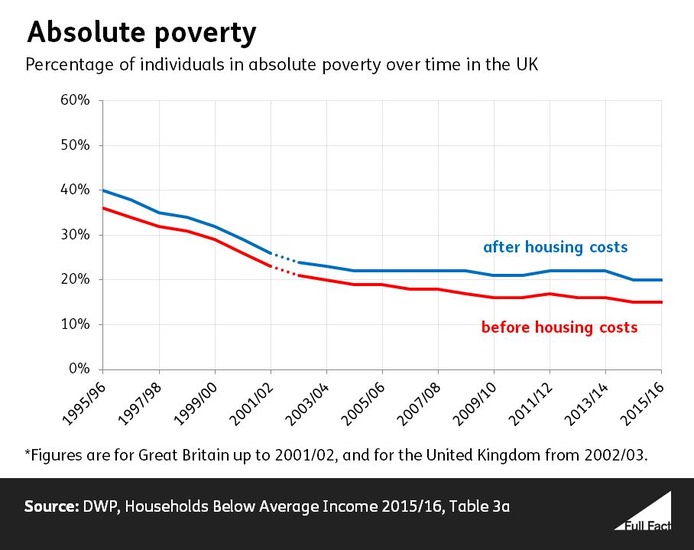14 million people, a fifth of the population, live in poverty. Four million of these are more than 50% below the poverty line, and 1.5 million are destitute, unable to afford basic essentials. The widely respected Institute for Fiscal Studies predicts a 7% rise in child poverty between 2015 and 2022, and various sources predict child poverty rates of as high as 40%. For almost one in every two children to be poor in twenty-first century Britain is not just a disgrace, but a social calamity and an economic disaster, all rolled into one.
The quote above is from a report by by Professor Philip Alston, United Nations Special Rapporteur on extreme poverty and human rights, following a specific visit to in some sense inspect the UK.
What is poverty?
[3] says the UK no longer has an official measure of poverty for children, adults or pensioners. ¹ This leaves a situation where policymakers and politicians are less able to track progress and it is more difficult to hold them to account for effectively tackling the causes of poverty or improving the lives of those in poverty.
Looking for previous definitions i have used within these pages I found that there’s a federal poverty line of $25000 per year per household. Also that I wrote about poverty last Christmas Day, of all dates. Of course, poverty is far more complex than a number [4] However, for the purposes of counting, many start with the bottom 20% of their nation. This points to an early distinction to make, between absolute poverty and relative poverty.

There are several types of poverty:
Absolute poverty. [T]he World Bank defines poverty in absolute terms [….] measured against a fixed standard of living. In October 2015 the World Bank set a new global poverty line at $1.90 a day. [4] Which would be £540 per year. I don’t see how that could happen in Britain.
The 2010 Act defined UK absolute poverty as being below 60% of a base figure originally set when the Act passed, which only changes with inflation. [7] For UK figures, this is a good short-term measure, since concepts of poverty change with time. This produces a disturbingly high number, 13 million people 20% (14 million, 20%, in relative poverty from the same source, [8] 2015/6 figures.

Relative poverty considers your location and what it means to be poor in a particular society. It measures if your income falls below the minimum amount needed for you to maintain the average standard of living in the society you live in. In the UK, relative poverty when household income falls below 60% of the UK median income. ² This defines one sort of poverty in the UK. that number is about £16800. ² [7] says the number of people living in the UK in relative poverty to be 13.44m (21% of the population) In 2016, and that the rate of poverty had remained broadly flat since 2004/5. Relative poverty is drastically affected by housing costs, leading to measures before and after (BHC, AHC). For example [8] says the 2015/6 figures indicate the AHC absolute poverty was 20% and the BHC 15%, while the relative poverty figures were around 21% AHC and 16% BHC
Persistent poverty. Poverty is not a fixed state. Families pass in and out of this state and so there is a separate concern for those in persistent poverty. [7] says this is at 6.5% of the population in 2014, while [3] says this is twice a s high in 2016. Persistent poverty is being in (relative) poverty for any three of the previous four years.
Fuel poverty is where 10% or more of disposable income disappears on all fuels including heating, around 3.5% of the population.
Water poverty is where 3% or more of disposable income goes on water bills, 10% in 2006
More to write, but I’m stopping for the weekend.
DJS 20181207
[1] https://www.ohchr.org/EN/NewsEvents/Pages/DisplayNews.aspx?NewsID=23881&LangID=E Do read it for yourself.
[2] https://www.ohchr.org/Documents/Issues/Poverty/EOM_GB_16Nov2018.pdf the pdf version of the report.
[3] http://socialmetricscommission.org.uk/MEASURING-POVERTY-FULL_REPORT.pdf
[4] https://www.compassionuk.org/blogs/poverty-101-what-is-poverty/
[7] https://en.wikipedia.org/wiki/Poverty_in_the_United_Kingdom As well written as ever.
[8] https://fullfact.org/economy/one-in-five-poverty/ I took the DWP tables from here.
1 There was a UK-wide official measure of poverty, with associated targets, contained in the Child Poverty Act 2010. Targets based on reducing child poverty in the UK were abolished in 2015. Note that Scotland, Wales and Northern Ireland have retained measures of poverty based around the Child Poverty Act 2010 definitions. {3, p14] The Act used measures to do with low income both relative and absolute, material deprivation and persistence. The 2010 Act was repealed in 2015, amid a restructuring of goals around a wider measure of life chances, also taking in issues such as debt and addiction. The Child Poverty Unit was absorbed into the DWP in 2016 [see].
2 Median what income? Median household disposable income, £27300 in 2017. This makes the 60% mark £16800, which I note is the same number demanded as minimum holdings or earnings per year when applying to the Home Office for a visa. Except that the £16800 is net income, not the quite same as disposable, though I can see that there is a need for simplification in arriving at a number. I’m struck that this is oddly low given what we scream from the rooftops about wanting to restrict immigration. I note that a retired household is doing well to be above this line, median for this sub-group being £22500 (and 60% of that is £13500). Non-retired households have a median of £30,000, so their median is £18000 (which (I suggest is where the Home Office line ought to be) and conversely that makes the £16800 figure 56% of the non-retired median. See [6] at some length.
The 2010 Act defined the 60% as 60% of equivalised net, before-housing
costs, median income. [3]